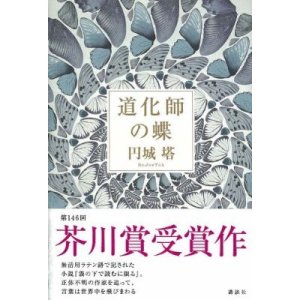平成二十四年二月十二日 立春 黄鶯睍睆(次候)
There are already a number of English blogs and news sources that have provided timely coverage of the details regarding the 146th Akutagawa Prize, so I’d like to skip over the general information, and just dedicate my first entry to Enjoe Toh’s winning piece, 道化師の蝶 Dokeshi no Cho.
As a result of both my focus on older Japanese literature and my general lack of experience, I only heard of Enjoe Toh for the first time last month when he was announced as a prizewinner along with Tanaka Shinya. Since a decent number of Akutagawa prizewinners have yet to be translated into English, I was pleasantly surprised to find that Enjoe Toh has already had some of his work translated, appearing in Speculative Japan 2 and elsewhere. Hopefully the trend will continue, and Dokeshi no Cho will enjoy a speedy translation.
The Bungeishunju special march edition hit stores on Friday, so after I got off work I was finally able to go and casually pick up both of the winning pieces for only a fraction of the cost. What with all the drama surrounding Tanaka Shinya and the numerous book reviews describing “Cannibalism” as dark, graphic and disturbing (go figure?) I decided that I’d start off by reading Enjoe Toh’s story, which seemed more appealing.
I’m aware that 道化師の蝶 is already being translated on different blogs as “The Clown’s Butterfly,” but after a read through it’s apparent that “The Harelquin Butterfly” would be a more appropriate title. (I have changed the word “clown” to “harelquin” because Enjoe Toh assigns the reading「アルルカン」to 道化師. I have also reinterpreted the particle の because within the text the butterfly itself is directly compared to a harelquin.)
Over all, I thoroughly enjoyed the text; it’s a satisfying flight of fancy that muses about many facets of linguistic theory and more. Most striking, of course, is the story’s unconventional plot structure, which mimics a mobius band. (If you’re not sure what that would look like, then I recommend you read the story!)
Up until now I haven’t spent any time doing literary translation, but I thought it might be fun to put aside a little time after dinner tonight in order to translate the very first part of the story. Honestly, the radical changes that occur over the following sections are not easy to predict from the opening, which I’ve provided below; at the same time, I figured that translating any more than I have would be overdoing things.
And so the below is my quick attempt at a translation of the story’s opening, with all respect to Enjoe Toh, and the sincere hope that this translation will encourage readers to go, pick up a copy, and read the rest of the story. Enjoy!

The Harlequin Butterfly by Enjoe Toh
First, to the people whose names begin with an A.
Then, to those whose names begin with a B, a C, and so on.
Similarly, to those whose names begin with a vowel.
And then to those that begin with an F sound, then a V sound, and so on.
One after another, according to all the kinds of divisions that happen to exist.
I no longer know how to decide what is referred to by the intersecting points of the net, but what other method could there be other than this?
1.
One should have a book that can only be read while traveling. Only having a book that can also be read while traveling is boring. There is a proper place and time for everything, and something that can be tolerated anywhere is nothing more than a lackadaisical sham.
The sort of book made to be read while traveling would surely be similar to something like “The Book That Can Be Read In 2 Minutes While Doing A Handstand,” which would of course be a book that has been written to be read while doing a handstand. If such a book were read while not doing a handstand, then the meaning of it would elude the reader. Naturally, they would be able to open the book and run their eyes across the characters on the page at any time—but the reading experience would be incomparable to that of reading while doing a handstand. It would surely be a story that cleverly makes use of the blood that rushes to the reader’s head. By applying this line of thought, one could easily create moments like “The Revelation That Occurs When You Become Enraged.”
It was something that occurred during the flight between Tokyo and Seattle. Resting on my knees was a copy of “A Confession To The People Who Have Three Arms,” which I had purchased at a kiosk. While I tried flipping through the pages, as usual none of the content made it into my mind. Whether by some fault of the speed at which the plane was traveling, the letters on the page had fallen slightly behind, and almost seemed to be hurriedly trying to catch up. Distracted by the letters’ panicked movements, rather than grasping the content of the book, I could only register that I was looking at a publication, and was utterly unable to convince myself to continue reading.
Once I gave up on any meaningless attempt to persist, I began thinking instead about a book that would make use of the letters’ movements. Whenever I go on a trip, I always have the same problem. Despite the fact that I travel with two or three books in my suitcase, and always buy another book that catches my attention at my destination, I’m never able to make any progress reading.
Salesmanship must be the witty ability to turn indecisive sensations not into words, but into money.
Even if you would not call him extremely wealthy, the reason that Mr. A. A. Abrams was able to acquire a considerable fortune was because he very seriously picked up what was nothing more than one of my casual musings.
It was something that occurred during the flight between Tokyo and Seattle.
Mr. A. A. Abrams is a man who flies year round, with no particular destination. Rather, he makes a living flying around, riding in as many airplanes as he can, and only staying at a hotel near the airport when it can’t be avoided. But he is neither a flight attendant nor a pilot; he’s a passenger with no particular destination.
Having forced his obese body into his economy class seat, Mr. A. A. Abrams waited for his fat to acclimate to its new restraints. By the time the plane reached cruising altitude his fat had settled and, after ordering one bottle each of red and white wine, he reached into his jacket pocket to remove something.
What he produced was a small bag sewn from silver thread, wrapped around a grease-stained spindle that shown with a black luster. Using his sausage-like fingers, Mr. A. A. Abrams delicately removed the bag from the black pole, and as though he were arranging a doll’s hair, opened it up with almost licentious movements.
From between his hairy fingers, a small insect net appeared. Like the giant in Brobdingnag, he carefully put his pointer finger and middle finger together, and then, gently pinching the net between his thumb and two fingers, held it level.
As though conducting a hum, he began to lightly twitch the net.
Out of the corner of his eye he gave me a searching look where I sat in the seat next to him, and then after a brief glance at the book resting on my knees, knitted his brow. Plainly assuming that I would be interested in what he had to say, Mr. A. A. Abrams began to ramble to me in his strong American accent.
“You see, my work is to go around collecting ideas. I’ve tried doing this in a number of different places, but in the end I discovered that the best place to catch ideas is in flight on large passenger planes. While traveling, people have all sorts of ideas, which then leave their bodies to float around in the air above us. There’s a lot of useless rubbish in the bunch, but it’s far better than sitting around in a conference room and trying to squeeze out bits of wisdom that never even existed in the first place. The long and short of it is that ideas hold everything together, and a business is an animal that constantly requires new ideas in order to stay alive. Essentially, what I do is go around catching food to keep the beast alive.”
Taking the net in his left hand, Mr. A. A. Abrams turned to me and pretentiously began again, saying, “This, you see, it made of silver thread. It was produced using the same methods for making filigree, and is interwoven with countless invisible incantations. I had a worker in Afghanistan specially order it. You see, ideas hate metal, but you can’t catch them with anything taken from an animal. I invested a lot of time and money before finally discovering that silver thread was suitable to the task. Bad spirits seem to avoid silver. In other words, as bad ideas naturally avoid this net, I’ve managed to avoid catching anything unnecessary—two birds with one stone, if you will.”
While complacently shifting my gaze back and forth between Mr. A. A. Abrams and his net, I bought the time I needed to translate what he had said. I waited patiently for my mind to rearrange the sentences and check the vocabulary against the little dictionary in my head. Once I felt that I understood the gist of what this giant meatball had suddenly said, I smiled and replied, “I see. I think I know what you mean. After all, I can never read when I’m traveling.”
Whether or not Mr. A. A. Abrams was able to understand my clumsy English, he seemed unable to make up his mind about something I had said, and knitted his brow again. The casual flicking movement that had been lightly jerking the insect net ceased. After examining my face for a moment, Mr. A. A. Abrams ceremoniously lifted up his log-like arms for me to see, and then gently placed the silver net over my head.
“Would you care to tell me about it?”

